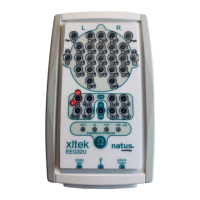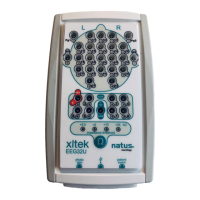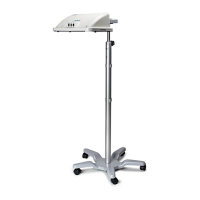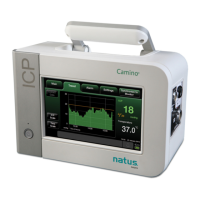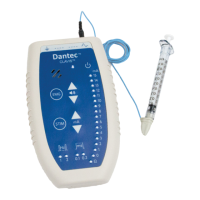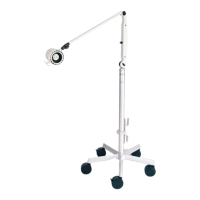XLTEK Protektor32 Instructions for Use
43
3. Select a Contralateral Sound. This setting allows you to select which type of stimulation to use
in the ear that is opposite to the ear that is being monitored.
• Masking Tone: A contralateral sound used for auditory stimulation raises the threshold of
audibility for the ipsilateral sound by the presence of another (masking) sound.
• Noise: The contralateral sound used for the test lowers the threshold of audibility for the
ipsilateral sound by the presence of another random, discordant sound.
• Silence: No contralateral sound is used for the test if Silence is selected.
4. In the Visual section, set the stimulator unit for Pattern Reversal or Goggles.
• Stimulator: Use the Stimulator pull-down menu to select the type of stimulator hardware that
will be used for the test. You can choose either Goggles or Monitor. All of the settings below
are for Monitor only.
• Modality: The Modality pull-down menu allows you to select the visual pattern that will be
used for the visual stimulation. You can choose from Stripes or Quadrants (a checker-board
pattern).
• Color: You can specify the color of the stimulation pattern. Choose from Black, Red, Blue or
Green. This feature is only available when Monitor is selected as the visual stimulator.
• Acquire On: Use the Acquire On pull-down menu to specify which colors will trigger the
acquisition of EP data: Both, White or Color. This feature is only available when Monitor is
selected as the visual stimulator.
• Rate [Hz]: Type a value into the Rate [Hz] text box to set the rate of the visual stimulation in
Hertz.
• Flash: Select this box to display a gray pattern in between two quadrant/stripe patterns on
the monitor.
5. Click Save.
H) Timelines Tab
Timelines are used to tell EPWorks when to start gathering a new set of waveforms. You can set your
timeline to be Interleaved or Consecutive. You can further modify the timeline to run continuously; to run
once and never restart; or to run on intervals. A timeline is mainly used for interleaving stimuli when using
two or four-limb stimulation.
